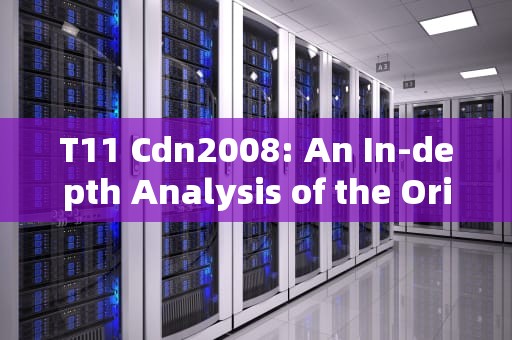Introduction

The concept of Content Delivery Network (CDN) has been around for several decades. However, it was in the year 2002 that a significant milestone was achieved with the release of the T11 CDN standard. This article aims to provide an in-depth analysis of the origin, development, and impact of T11 CDN on the global network landscape.
The Origin of T11 CDN
The T11 CDN standard was developed by the Internet Engineering Task Force (IETF) in response to the growing demand for faster and more reliable content delivery across the internet. The goal was to create a set of guidelines that would enable service providers to deliver content to their users in a more efficient and cost-effective manner.
The T11 standard defined three main components of a CDN: edge nodes, cache servers, and content servers. Edge nodes are responsible for distributing content across the network, while cache servers store frequently accessed content locally to reduce the load on the backbone network. Content servers are used to store original content that needs to be delivered to users who have not yet accessed it.
Development of T11 CDN
The development of T11 CDN was a collaborative effort involving several organizations, including Microsoft, AOL, EarthLink, and others. These companies provided funding and technical expertise to help refine the standard and ensure its success.
One of the key features of T11 CDN was its focus on performance optimization. The standard included guidelines for caching strategies, data compression, and other techniques that could improve the speed and reliability of content delivery. It also included support for advanced features such as adaptive bitrate streaming (ABR), which allows content providers to deliver content at different quality levels based on user preferences and network conditions.
Another important aspect of T11 CDN was its scalability. The standard was designed with flexibility in mind, allowing service providers to scale up or down depending on their needs. This meant that smaller service providers could adopt the standard without being overwhelmed by its complexity, while larger providers could take advantage of its advanced features to deliver better experiences to their users.
The Impact of T11 CDN on Global Network Landscape
The impact of T11 CDN on the global network landscape has been significant. Since its release in 2002, the standard has become widely adopted by both large and small service providers around the world. Today, almost every major internet service provider uses some form of CDN technology to deliver content to their users.
One of the biggest benefits of T11 CDN is its ability to improve website performance and user experience. By distributing content across multiple servers located around the world, CDNs can reduce latency and increase bandwidth efficiency, resulting in faster page loads and smoother navigation for users. This has led to increased user engagement and loyalty for websites that use CDN technology.
Another benefit is its ability to reduce costs for service providers. By offloading content delivery onto a distributed network, service providers can reduce their dependence on expensive backbone networks and lower their overall infrastructure costs. This has made CDN technology an attractive option for businesses of all sizes, including startups and SMEs.
T11 CDN has also had a positive impact on content distribution models. With the advent of CDN technology, content providers can now reach a broader audience by delivering their content globally through a network of的边缘服务器,这种分布式网络结构使得内容提供商能够更有效地分发内容,提高其在全球范围内的可见性和影响力。
However, there are also challenges associated with CDN technology. One of the main concerns is security. As content is distributed across multiple servers, there is a risk of unauthorized access or data breaches. To address this issue, many CDN providers implement strict security measures such as encryption and authentication protocols to protect sensitive data.
Another challenge is interoperability between different CDN providers. While T11 provides a common framework for CDN technology, there may still be differences in how different providers implement certain features or handle specific scenarios. This can lead to compatibility issues between different CDN services or even conflicts between different versions of the same standard. To address these issues, ongoing collaboration and标准化 efforts are needed among stakeholders in the industry.
Future Developments in T11 CDN Technology
As we look ahead into the future, there are several potential developments that could further advance T11 CDN technology and enhance its value proposition for service providers and end-users alike. One area where we could see significant progress is in improving scalability and flexibility further than what is currently available under the T11 standard itself. By introducing new mechanisms for dynamic resource allocation and auto-scaling capabilities within CDN networks, we could enable more efficient use of resources while maintaining high levels of performance and reliability throughout changing network conditions or traffic patterns over time.
Another potential direction for future development involves integrating advanced analytics tools into T11 CDN architectures so that real-time monitoring and optimization can be performed automatically based on metrics such as user behavior patterns or system performance metrics gathered from various sources within the network itself. Such capabilities would enable more intelligent decision making processes at both the individual server level as well as across entire networks, potentially leading to improved overall efficiency gains across all parties involved in content delivery operations.
Finally, one final area where we might see significant advancements relates to enhancing security measures within CDN environments further beyond what is already presently available today under existing standards like HTTP/2 or even more advanced protocols like HTTP/3 if they become widely adopted in practice over time. By incorporating additional layers of encryption or authentication protocols specifically tailored towards protecting sensitive data during transmission or storage phases within CDN networks themselves rather than relying solely upon external security solutions applied at higher levels within application layer protocol stacks like web browsers or operating systems generally speaking; we could achieve greater levels of assurance regarding privacy protections afforded to users accessing content via these networks in accordance with relevant regulations governing personal data handling practices worldwide today.
随着互联网的普及和信息技术的飞速发展台湾vps云服务器邮件,电子邮件已经成为企业和个人日常沟通的重要工具。然而,传统的邮件服务在安全性、稳定性和可扩展性方面存在一定的局限性。为台湾vps云服务器邮件了满足用户对高效、安全、稳定的邮件服务的需求,台湾VPS云服务器邮件服务应运而生。本文将对台湾VPS云服务器邮件服务进行详细介绍,分析其优势和应用案例,并为用户提供如何选择合适的台湾VPS云服务器邮件服务的参考建议。

工作时间:8:00-18:00
电子邮件
1968656499@qq.com
扫码二维码
获取最新动态
